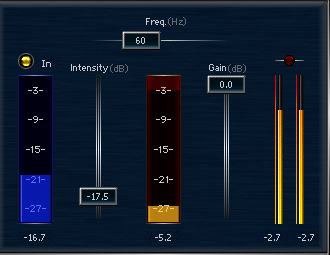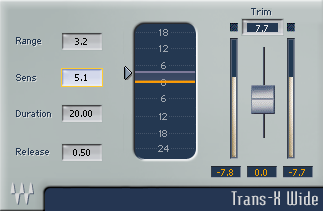In any genre, whether it’s electronic music or one of numerous subgenres of rock, the kick drum is one of the most important elements. It gives the backbone to a mix, adds a low frequency pulse and is undoubtedly the most important part of groove. In this article, we’re going to figure out how to add punch to a kick drum, in other words, to turn it out of a sound which is “just there” into “heart beating” of your song!
1. Compression
When it comes to live drums, the compression is the first solution that comes to mind. While applying it, we equalize the volume difference of separate kicks that emerges inevitably when a real drummer is playing. Whereby quiet kicks become subjectively louder, and their weight in an overall mix rises. But the compression allows us to go beyond this strictly technical goal!
The waveform of a drum sound has a short sudden peak at the very beginning (attack), then a sudden decay and a small rapidly fading out section – the “body” of a drum. To add punch to a kick drum, you need to reduce the difference between attack and body loudness. Compression copes with that perfectly. The emerging sound saturation with additional harmonics (while applying hardware devices and their emulations) adds some weight to a bass drum. Furthermore, it’s important not to set a compressor to a too short attack. For a live kick, the attack varies from 3 to 20 ms depending on the situation. Release must also be short (3–5 ms) as the compressor must reduce only the peak volume at the very beginning of the drum sound. Ratio is equal to 4:1–5:1.
2. Parallel Compression
During mixing of live drums, parallel compression works in tandem with basic compression as a rule.  When you run out of the capacity of the compression applied as insert, to add weight to a kick drum, you need to create an AUX bus send with another compressor or to double the track you have and to apply compression to a copy. Regardless of what technique is appropriate for you personally, the point of the procedure is to flatten the copy of the signal to the maximum and to mix to the basic drum sound. Therefore, the basic kick drum keeps sounding natural and dynamic, and the added flattened copy helps it not to get drowned in the mix and adds punch.
When you run out of the capacity of the compression applied as insert, to add weight to a kick drum, you need to create an AUX bus send with another compressor or to double the track you have and to apply compression to a copy. Regardless of what technique is appropriate for you personally, the point of the procedure is to flatten the copy of the signal to the maximum and to mix to the basic drum sound. Therefore, the basic kick drum keeps sounding natural and dynamic, and the added flattened copy helps it not to get drowned in the mix and adds punch.
Keep in mind the bonus: during aggressive compression with hardware devices or soft emulations, the sound gets distorted very much what along with the saturation of the flattened copy with a great number of harmonics adds even more color and warmth to the basic kick drum.
Now, about possible compressor settings in details:
- A long attack + a short release (on my favorite CLA-76, the Attack control is turned to the left to the max, the Release – to the right to the max). This is a classical technique! It allows you to achieve greater values of Gain Reduction with preservation of punchiness.
- A long attack + a long release. The CLA–76 Attack settings are the same, and Release parameters vary in the range of 6–4. Use these settings if you need to maximally emphasize a drum attack.
- A short attack + a long release. Use these settings if you need to maximally emphasize the body of the drum.
When I was speaking about compression and parallel compression, I was right to lay stress on processing of live drums as in this case you have to do with a raw record. In case with samples, these kinds of processing can be optional as in most cases sounds in libraries have already been compressed.
3. The use of Exciters
This technique is applied both in mixing of live drums  and in the work with samples. Its point is in the creation of additional low frequency harmonics with plugin-exciters. Among well-known plugins, I can name MaxxBass and RBass from Waves, iZotope Ozone exciter, Clarisonix from Plug & Mix.
and in the work with samples. Its point is in the creation of additional low frequency harmonics with plugin-exciters. Among well-known plugins, I can name MaxxBass and RBass from Waves, iZotope Ozone exciter, Clarisonix from Plug & Mix.
The technique itself is simple:
- Place an appropriate exciter into insert of a drum track and enhance harmonics a little. Even if you exceed in the amount of them a bit, you shouldn’t get scared at this stage. Above all, make sure that the kick volume is approximately the same while the plugin is on or off.
- Afterwards, by changing focus frequency, find that frequency which will add the maximum weight and punch to a kick and will show it in the mix best of all. An important tip: on no account, seek this value while playing the kick in solo! All settings should be done only in the context of the entire mix.
- When you find the necessary frequency, add the final value of harmonics enhancement.
RECOMMENDED ARTICLES:
- HOW TO REMIX A SONG
- HOW TO PERFORM ELECTRONIC MUSIC LIVE
- HOW TO MASTER MUSIC LOUDER AND WITH MORE COLOR
- HOW TO MIX ELECTRONIC DANCE MUSIC LOUD AND CLEAN
- WHAT IS MID SIDE PROCESSING
- ADDING DYNAMICS TO A MIX IN 1 STEP
4. Transients Enhancement
This technique is also equally good for live  and sampled drums. As you know, compression changes the character of drum sound and affects their attack partly. So, after it, it’s useful to restore part of the lost transients with transient designer plugins. In case with drums in electronic music, attack enhancement of a kick drum with transient designers allows it to break through the wall of synthesizers much better.
and sampled drums. As you know, compression changes the character of drum sound and affects their attack partly. So, after it, it’s useful to restore part of the lost transients with transient designer plugins. In case with drums in electronic music, attack enhancement of a kick drum with transient designers allows it to break through the wall of synthesizers much better.
5. Parallel attack processing
How to add more punch to a kick drum and along with that to give specific character/color to its attack?
The following interesting technique will help with that. Make two copies of a drum track and send them to the overall AUX bus. Invert the polarity of one of the copies with help of any plugin with this option. The consequence of the emerged effect of mutual signals subtraction will be total silence at the output! The sounds on both tracks indeed have absolutely identical waveform but with the opposite polarity!
Now put a transient designer on the non-inverted track and enhance a kick drum attack a little. Since the kick drum attack has changed, the mutual cancellation effect doesn’t influence it any longer. And on AUX bus, you will hear an ideally isolated kick drum attack without any slightest side tone of the body. Now you’re free to do with it everything what your imagination and the conditions of a certain mix will prompt: to saturate, equalize, equalize with vintage equalizers (to combine equalization and saturation effects), apply exciters. Alternatively, you can use a multiband transient designer if you want to emphasize only a specific frequency range of the attack.
I hope that now the question how to add weight and punch to a kick drum won’t be an issue for you. In this article, I have collected all the techniques known for today! You only have to try them out in practice and feel the nuances of each technique. With experience, you will learn to define which out of techniques will work out in a concise mix best of all.
Please learn EKmixmaster's mixing and mastering services pricing.
Any specific topic that you'd want to learn about?
Any other questions?
Feel free to ask - I'd love to help!
